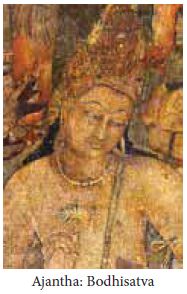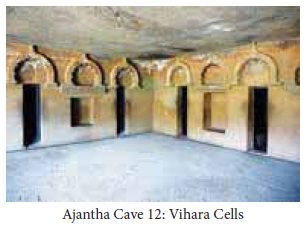South India | History - Ajanta | 11th History : Chapter 9 : Cultural Development in South India
Chapter: 11th History : Chapter 9 : Cultural Development in South India
Ajanta
Ajanta
The Ajanta caves are situated at a distance of about 100 km north of Aurangabad in Maharashtra. Totally 30 caves have been scooped out of volcanic rocks. Though chiefly famous for mural paintings, there are some sculptures too. T he Hinayana sect of Buddhism started the excavation of caves in Ajanta. The patrons were the kings who ruled the Deccan plateau during the period c. 200 BCE to 200 CE. Inscriptions speak of the patrons who range from kings to merchants. First phase of the caves belong to the period from c. 200 BCE to 200 CE. The second phase started from c. 200 CE to 400 CE.
Paintings
Ajanta caves are the repository of rich mural paintings. Paintings of the early phase are mostly in caves nine and ten, which belong to the period of the Satavahanas. The authors of Ajanta paintings followed ingenious techniques. First, they plastered the ridged surface of the volcanic rock. This plaster was made of vegetable fibres, paddy husk, rock-grit, and sand. This surface was overlaid with a thin layer of lime, ready to receive the pigment. Recently it was noticed that a stretch of cloth was reinforced on the surface for the application of pigment.
The colours were extracted out of natural objects and minerals. The prominent colours used are black, red, white, yellow, blue and green. The aesthetic features of the paintings are garland, necklaces, headgear, ear-rings and the perfection of the movements of the human hands. The story panels are attractive and informative. Scenes from the Jataka stories and select episodes from the life history of Buddha are the central theme of the paintings.

The celestial figures of Kinnaras, Vidyadharas and Gandharvas are depicted in paintings and sculptures. In the paintings of the later period Bodhisattva is shown in larger relief. Though a variety of human moods are presented, the dominant ones are of compassion and peace. Light and shadow are intelligently used. Human figures depicted in different colours have been interpreted to mean that they are from different ethnicities.
Architecture and Sculpture
Architecturally, Ajanta caves are grouped into two: chaityas and viharas. The chaityas have vaulted ceilings with long halls. In the rear end of the halls the statue of Buddha is seen. The sculpture of Buddha in the garba-griha is in the classical model. His image is the embodiment of benevolence. Heaviness is the general character of the sculptures. Sculptures of Yakshis and Hariti with children are significant. Bodhisattva carved out independently is another important feature. The popular Bodhisattva Avalokitesvara is depicted in painting and sculpture.

Related Topics